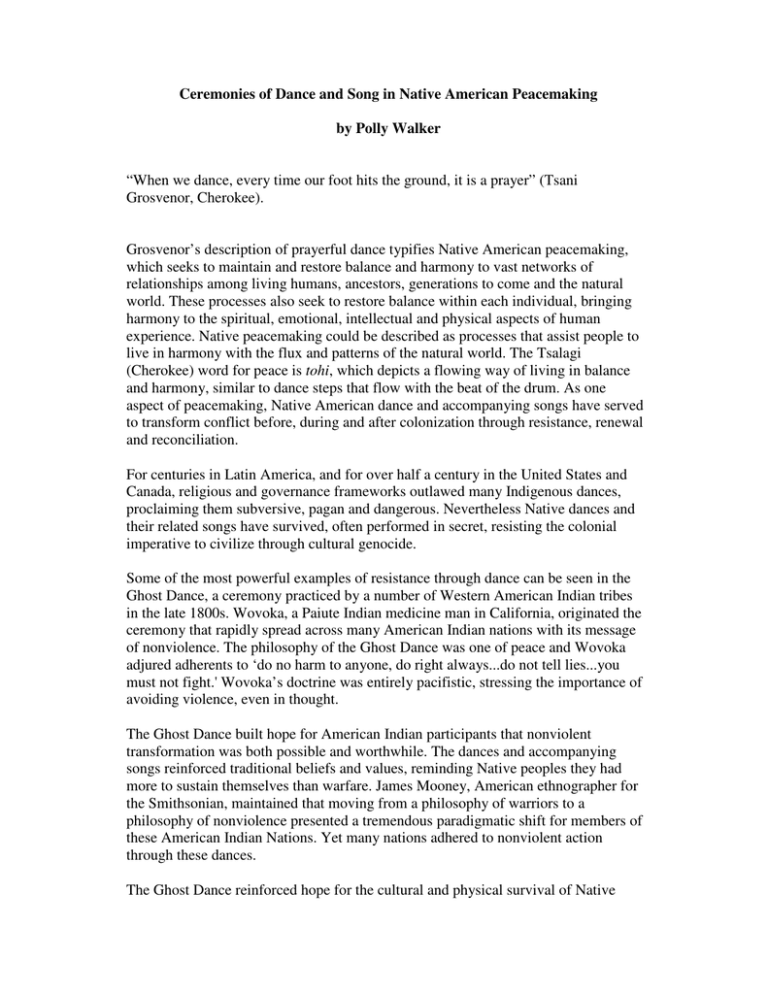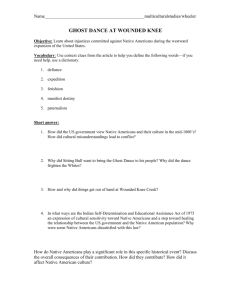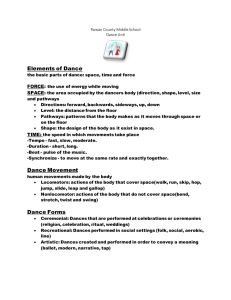Ceremonies of Dance and Song in Native American Peacemaking
advertisement

Ceremonies of Dance and Song in Native American Peacemaking by Polly Walker “When we dance, every time our foot hits the ground, it is a prayer” (Tsani Grosvenor, Cherokee). Grosvenor’s description of prayerful dance typifies Native American peacemaking, which seeks to maintain and restore balance and harmony to vast networks of relationships among living humans, ancestors, generations to come and the natural world. These processes also seek to restore balance within each individual, bringing harmony to the spiritual, emotional, intellectual and physical aspects of human experience. Native peacemaking could be described as processes that assist people to live in harmony with the flux and patterns of the natural world. The Tsalagi (Cherokee) word for peace is tohi, which depicts a flowing way of living in balance and harmony, similar to dance steps that flow with the beat of the drum. As one aspect of peacemaking, Native American dance and accompanying songs have served to transform conflict before, during and after colonization through resistance, renewal and reconciliation. For centuries in Latin America, and for over half a century in the United States and Canada, religious and governance frameworks outlawed many Indigenous dances, proclaiming them subversive, pagan and dangerous. Nevertheless Native dances and their related songs have survived, often performed in secret, resisting the colonial imperative to civilize through cultural genocide. Some of the most powerful examples of resistance through dance can be seen in the Ghost Dance, a ceremony practiced by a number of Western American Indian tribes in the late 1800s. Wovoka, a Paiute Indian medicine man in California, originated the ceremony that rapidly spread across many American Indian nations with its message of nonviolence. The philosophy of the Ghost Dance was one of peace and Wovoka adjured adherents to ‘do no harm to anyone, do right always...do not tell lies...you must not fight.' Wovoka’s doctrine was entirely pacifistic, stressing the importance of avoiding violence, even in thought. The Ghost Dance built hope for American Indian participants that nonviolent transformation was both possible and worthwhile. The dances and accompanying songs reinforced traditional beliefs and values, reminding Native peoples they had more to sustain themselves than warfare. James Mooney, American ethnographer for the Smithsonian, maintained that moving from a philosophy of warriors to a philosophy of nonviolence presented a tremendous paradigmatic shift for members of these American Indian Nations. Yet many nations adhered to nonviolent action through these dances. The Ghost Dance reinforced hope for the cultural and physical survival of Native peoples who were facing starvation, dislocation, and death at the hands of White settlers and agents of the American Government. One role of the Ghost Dance songs was to resurrect the traditional knowledge the people needed to strengthen and sustain themselves in the task of living nonviolently in the face of extreme violence on the part of the American Army and vigilante groups. The songs also protested epistemic violence by giving voice to traditional Indigenous knowledge systems, nonviolently resisting the colonial restrictions against their dissemination. It was this compendium of traditional Indigenous knowledge that the colonial authorities sought to destroy, and that the Ghost Dancer participants voiced through movement and song. Contemporary American Indian music continues to celebrate the ways in which American Indian peoples are strengthened by the principles of nonviolence underlying the Ghost Dance. In his song ‘Ghost Dance,’ Robbie Robertson, a musician of Mohawk descent, illuminates the principle of loving nonviolent resistance that formed the philosophical underpinnings of the Ghost Dance ceremony. This stance taken by the Ghost Dancers demonstrates principles of nonviolence similar to those of Gandhian satyagrahis who are exhorted to not fear for their bodies, but to respond to violence with love. Through Robertson’s songs, modern day listeners are encouraged to reflect on the power of this stance which has been described as moral ju-jitsu, deflecting violence with love. Robertson’s lyrics state: You can kill my body You can kill my soul For not believing in your god And some world down below… You don’t stand a chance against my prayers You don’t stand a chance against my love. In “Ghost Dance’, Robertson also uses words from a historical Commanche Ghost Dance song, illustrating the ways in which the music encouraged Ghost Dancers to maintain hope for a better life, even though they were surrounded by settler peoples seeking their extinction. In the following verse, this Comanche song encourages the Ghost Dancers to not give up in the face of extreme violence, but to hope for a better era: We shall live again, We shall live again. Robertson also incorporates lyrics from a traditional Ghost Dance song of the Crow Nation. The words of this song encourage American Indian tribes to hold onto their values and traditions until conditions improve and they can freely and openly live in ways that reflect their values and beliefs. In Robertson’s music, traditional Ghost Dance songs are expressed in a modern format, calling for American Indian and First Nations listeners to keep hope alive, relying on the connections with the natural world that characterize their Native epistemologies. The words of the Crow Ghost Dance song relate this message: The whole world is coming A nation is coming, a nation is coming, The Eagle has brought the message to the tribe. The father says so, the father says so Over the whole earth they are coming. The buffalo are coming, the buffalo are coming. The Crow has brought the message to the tribe, The father says so, the father says so. The Ghost Dance provides an example of what John Paul Lederach calls the moral imagination, facilitating ‘stepping into the mystery’ of peace that lies beyond the cycles of violence Native peoples were experiencing. The Ghost Dance created a powerful liminal space for participants, and many of them went into a trance-like state where they reported visiting with ancestors who encouraged them to persevere in living in a good way. The Ghost Dance movement died out shortly after many of its adherents were massacred at Wounded Knee. However, the story of this principled nonviolent campaign continues to provide a moving example among contemporary American Indian Nations of the power of nonviolence and the role that dance and song can play in sustaining the participants within such movements. Native American dance, song and ritual continue to facilitate renewal of Native peoples relationships with each other, and with the natural world. No longer illegal in the United States or Canada, they are revitalizing Native nations, as McMaster and Trafzer explain: “Among many different Indian peoples the songs of the Earth, medicine power and holy rituals keep the Earth alive and moving. The grass grows and rivers flow. With one sky above, Indians conduct many internal and external expressions of our cultural ways. We sing our songs, perform our dances, and pray. In many ways we remember the old traditions, and by telling our stories of being, we reenter and renew our sacred circles. With each song, story, or ceremony, the Native world is re-created.” Native ceremonies are also incorporating descendents of settlers and immigrants in processes of reconciliation. For example, in 1999 at the breaking ground ceremony for the National Museum of the American Indian, both Native and non-Indigenous peoples returned to the land, with the beat of the drum affirming promises to tell the truth of the history of contact between Native and European peoples, about who Native peoples are now, and who they strive to be. Gabriel Tayac, Piscataway scholar describes the ritual: “ It felt, in that moment, that centuries of history had completed the turn of a great wheel. A wheel that in its five-hundred-year revolution, beginning in 1492, had wrought shattering cultural cataclysms; but one that had left enough of us standing to begin a healig process for both Native people and those who had come to our shores. We still have a long journey, but this is one that many recognize we must take together. We are all part of the story of this land now, and the choice to follow the original instructions in our own ways is open wide before us.” (p. 83) Both historical and contemporary Native dance and song facilitate restoration of balance and harmony among humans and the natural world – one of the central tenets of Native American peacemaking. Some of these dances are represented in an exhibition entitled “Circle of Dance,” which opened Oct. 6 at the Smithsonian’s National Museum of the American Indian in New York, George Gustav Heye Center. This exhibit features ten Native American social and ceremonial dances drawn from throughout the Americas. “These diverse social, ceremonial and spiritual dances are essential in maintaining the spiritual, physical and emotional well-being of tribal communities,” said Kevin Gover (Pawnee/Comanche), director of the National Museum of the American Indian. “This exhibition will demonstrate what an important tool dance is to the expression and vitality of Native peoples.” One dance represented in the exhibit is the Tlingit ku.éex', led by clan leaders along the Pacific Northwest Coast who dance wearing a headdress called a shakee.át. Eagle down, a sign of peace, is placed in the crown, and as the leader dances the eagle down spreads in the air and gently falls to the floor, blessing the ceremonial space. Much more than art forms, Native dance and songs are integral aspects of traditional peacemaking and conflict transformation processes. Settler descended people and immigrants may learn more about Native American peacemaking dance and song through the NMAI exhibit and through invitation participating in ritual and ceremony with local Native nations. Polly Walker is currently teaching as an Assistant Professor of Peace and Conflict Studies at Juniata College in Huntingdon, PA. She is a director of the Peace and Conflict Studies Institute Australian and lectures in peace and conflict at James Cook. Previously she was a research fellow in the Australian Centre for Peace and Conflict Studies, and Lecturer in the Aboriginal and Torres Strait Islander Studies Unit, University of Queensland in Brisbane, Australia. She is co-editor of "Acting Together, Performance and the Creative Transformation of Conflict" (2011) and has contributed to a number of professional journals and edited volumes. She is also a facilitator of computer assisted dialogue. Chair of the Indigenous Education Institute, Polly is of Cherokee descent and an enrolled member of the Cherokee Southwest Township. Her research focuses on cross cultural conflict resolution, transforming conflict between Indigenous and non-Indigenous peoples, and the role of ritual in these processes.


